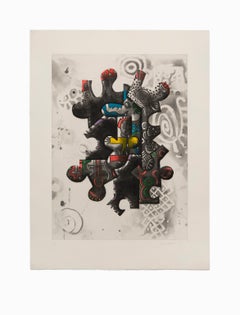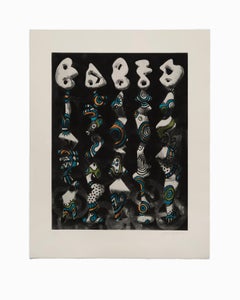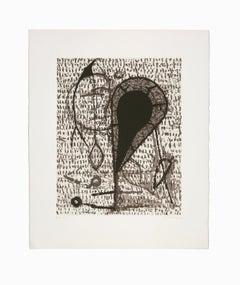Want more images or videos?
Request additional images or videos from the seller
1 of 24
David BarrDavid Barr "Four Corners Project" UofM Complete Portfolio Set of 4 Plus Booklet1981
1981
Price:$3,750
$4,160List Price
About the Item
- Creator:David Barr (1939 - 2015)
- Creation Year:1981
- Dimensions:Height: 19.25 in (48.9 cm)Width: 23.75 in (60.33 cm)
- Medium:
- Movement & Style:
- Period:
- Condition:
- Gallery Location:Detroit, MI
- Reference Number:1stDibs: LU1286112826282
About the Seller
5.0
Vetted Professional Seller
Every seller passes strict standards for authenticity and reliability
Established in 2014
1stDibs seller since 2019
110 sales on 1stDibs
Typical response time: 15 hours
Authenticity Guarantee
In the unlikely event there’s an issue with an item’s authenticity, contact us within 1 year for a full refund. DetailsMoney-Back Guarantee
If your item is not as described, is damaged in transit, or does not arrive, contact us within 7 days for a full refund. Details24-Hour Cancellation
You have a 24-hour grace period in which to reconsider your purchase, with no questions asked.Vetted Professional Sellers
Our world-class sellers must adhere to strict standards for service and quality, maintaining the integrity of our listings.Price-Match Guarantee
If you find that a seller listed the same item for a lower price elsewhere, we’ll match it.Trusted Global Delivery
Our best-in-class carrier network provides specialized shipping options worldwide, including custom delivery.You May Also Like
untitled, color abstract, original lithograph
Located in Belgrade, MT
This piece is part of my private collection of 20th Century artists that were part of the School of Paris era. This piece is original and signed by Pelayo and numbered.
Category
Late 20th Century Conceptual Abstract Prints
Materials
Paint, Acrylic, Lithograph
$320 Sale Price
20% Off
H 16 in W 11 in
Dario Villalba UNTITLED 4 Limited Conceptualism Spanish Contemporary Grey Woman
By Dario Villalba
Located in Madrid, Madrid
Dario Villalba - UNTITLED 4
Date of creation: 1975
Medium: Lithograph and photolithograph on paper
Edition: 75
Size: 95 x 68 cm
Condition: In mint conditions and never framed
Observa...
Category
1970s Conceptual Abstract Prints
Materials
Paper, Lithograph
$507
H 37.41 in W 26.78 in
Dario Villalba UNTITLED 3 Limited Conceptualism Spanish Contemporary Grey Woman
By Dario Villalba
Located in Madrid, Madrid
Dario Villalba - UNTITLED 3
Date of creation: 1975
Medium: Lithograph and photolithograph on Paper
Edition: 75
Size: 95 x 68 cm
Condition: In mint conditions and never framed
Observa...
Category
1970s Conceptual Abstract Prints
Materials
Lithograph
$406 Sale Price
20% Off
H 37.41 in W 26.78 in
Dario Villalba - UNTITLED 2 Limited Conceptualism Spanish Contemporary Grey
By Dario Villalba
Located in Madrid, Madrid
Dario Villalba - Untitled 2
Date of creation: 1975
Medium: Lithograph and photolithograph on paper
Edition: 75
Size: 95 x 68 cm
Condition: In mint conditions and not framed
Observati...
Category
1970s Conceptual Abstract Prints
Materials
Lithograph
$406 Sale Price
20% Off
H 37.41 in W 26.78 in
Dario Villalba UNTITLED 5 Limited Conceptualism Spanish Contemporary Grey Woman
By Dario Villalba
Located in Madrid, Madrid
Dario Villalba - UNTITLED 5
Date of creation: 1975
Medium: Lithograph and photolithograph on paper
Edition: 75
Size: 95 x 68 cm
Condition: In mint conditions and never framed
Observa...
Category
1970s Conceptual Abstract Prints
Materials
Archival Paper, Lithograph
$406 Sale Price
20% Off
H 37.41 in W 26.78 in
Blankless Tone, lithograph & silkscreen with embossing & folded corner. Signed/N
By Shusaku Arakawa
Located in New York, NY
Shusaku Arakawa
Blankless Tone, 1979
Color lithograph and silkscreen with embossing on Arches paper with deckled edges and folded collage upper left
Hand-signed by artist, Titled "Bl...
Category
1970s Conceptual Abstract Prints
Materials
Lithograph, Screen
The Relocation of Property by Natural Forces, with original colophon envelope
By Joe Zucker
Located in New York, NY
Joe Zucker
The Relocation of Property by Natural Forces
Rubber stamp print on Arches 88 paper
Stamp made by Unity Engraving Company, Inc.
Printed by Aaron Arnow
Paper size: 8 x 8 in...
Category
1970s Conceptual Abstract Prints
Materials
Lithograph
RARE Yvon Lambert Gallery mailer (Hand Signed and Addressed by Dennis Oppenheim)
By Dennis A. Oppenheim
Located in New York, NY
Dennis Oppenheim
Directed Seeding -Wheat, Historic Yvon Lambert Gallery Poster (Hand Signed and Addressed by Dennis Oppenheim), 1969
Offset lithograph poster. Hand signed, inscribed. Postmarked and addressed to Oppenheim's dealer, John Gibson
23 × 16 inches
Hand Signed and inscribed by Dennis Oppenheim lower right in blue marker in 2006, hand addressed by Dennis Oppenheim in 1969 in red marker
Unframed
This is an extremely uncommon vintage poster/mailer announcing the May 20th, 1969 opening reception (Vernissage) for the exhibition of works by American conceptual art pioneer Dennis Oppenheim at the Yvon Lambert Gallery in Paris. The poster is historic in that it was originally mailed to John Gibson, the East 67th Street dealer, who famously gave Dennis Oppenheim his first New York exhibition in 1968, and it is hand addressed to Gibson, bearing the original Paris, France postmark of 1969. It is, exceptionally, hand signed and dedicated by Dennis Oppenheim to a collector who acquired the poster from John Gibson's collection, and then secured Dennis Oppenheim's autograph in 2006, making this an especially valuable collectors item.
More information about the project from the Tate Gallery archives, which acquired the work:
This work brings together two interventions Oppenheim created on a field owned by farmer Albert Waalken in Finsterwolde, north-eastern Holland, in 1969. It comprises four distinct elements mounted on board: a colour photograph of a wheatfield being sowed by a tractor in parallel curving lines seen from high up; a negative image in black and white of a map of the area of Finsterwolde onto which two sections of text have been collaged; and two black and white aerial photographs of the same field being traversed by a tractor cutting an X into the wheat. The first two elements relate to the action Directed Seeding. For this the field was seeded according to a line plotted by following the road from the village of Finsterwolde, the location of the field, to Nieuweschans, another village where the farmer’s storage silo for wheat was located. Oppenheim reduced this curved line by a factor of six in order to direct the trajectory of seeding. The tractor then carved a series of curved parallel lines on the surface of the field as it dug up earth and scattered seed. From an aerial perspective the patterning of parallel lines may be viewed as a form of line drawing on the landscape. The precise location of the field and the silo are indicated on the map, showing the trajectory of the road. The two sections of text collaged onto the upper portion of the map briefly describe the two interventions. Explaining the action Cancelled Crop, the artist wrote:
In September the field was harvested in the form of an X. The grain was isolated in its raw state, further processing was withheld. This project poses an interaction upon media during the early stages of processing. Planting and cultivating my own material is like mining ones own pigment (for paint) – I can direct the later stages of development at will. In this case the material is planted and cultivated for the sole purpose of withholding it from a product-oriented system. Isolating this grain from further processing (production of food stuffs) becomes like stopping raw pigment from becoming an illusionistic force on canvas. The esthetic is in the raw material prior to refinement, and since no organization is imposed through refinement, the material’s destiny is bred with its origin.
(Quoted from artist’s statement in Tate acquisition file.)
Directed Seeding and Cancelled Crop are two separate works, brought together in several different versions of which Tate’s is one. The collage presents three ways in which human action may marks the land. For the first two, agricultural machinery is used to create straight lines, in the process of harvesting as in the X of Cancelled Crop, or curved lines, during the process of planting seed in the contours photographed for Directed Seeding. The map shows a third (and more ancient) way of marking the land, through the construction of roads. The use of the landscape – natural, industrial or urban – as a canvas on which to act is typical of Oppenheim’s work in the late 1960s and early 1970s. In a related action, Directed Harvest, 1966 (Tate T07590) and Directed Harvest 1968 (Kröller-Müller Museum, Otterlo, Netherlands), the artist caused a field to be harvested in linear patterns which he then had photographed in its progressive stages. In Reverse Processing: Cement Transplant, East River, NY, 1970, 1978 (Tate T07591) Oppenheim drew large crosses on the roofs of barges transporting raw cement that he found moored on the New York East River banks. All these works centre on process as an agent of change and utilise materials, elements and locations on which the artist can have no permanent claim, making them deliberately ephemeral. Such actions as seeding a crop and harvesting it several months later operate within time parameters dependent on the cycles of the seasons rather than the will of man, mixing human processes with those of nature. Oppenheim’s analogy between the prevention of a crop from entering the food chain and the halting of the expressive, ‘illusionistic’ force of paint deconstructs the sophisticated processes of art-making and the food industry to the elemental notion of making simple marks on the environment. In this way, the artist highlights contemporary man’s dependency on complex chains...
Category
1960s Conceptual Abstract Prints
Materials
Offset, Lithograph
Robert Smithson, Movie Treatment for Spiral Jetty, historic Dwan Gallery print
Located in New York, NY
Robert Smithson
Movie Treatment for Spiral Jetty, Dwan Gallery Poster, 1970
Offset lithograph poster
38 × 22 inches
Unframed
Rare, historic poster feature...
Category
1970s Conceptual Abstract Prints
Materials
Lithograph, Offset
Four Color Quartets, Abstract Lithograph by Mel Bochner
By Mel Bochner
Located in Long Island City, NY
Artist: Mel Bochner, American (1940 - )
Title: Four Color Quartets
Year: 1990
Medium: Four Lithographs, signed and numbered verso
Edition: 8/35
Overall Size...
Category
1990s Conceptual Abstract Prints
Materials
Lithograph
More From This Seller
View All"Untitled II", Abstract Aquatint Color Etching Lithograph, Signed and Numbered
Located in Detroit, MI
"Untitled II" is a work that displays James Hansen's intense colors and shapes of his abstract and surrealist style. This print made with etching and aquatints with hand-coloring on Arches paper pops with the illusion of three dimensions set against a muted background of esoteric shapes and symbols. The print is 32-3/4 x 26 inches and is signed and numbered from an edition of 30 by the artist. Numbered edition may not necessarily be number 28 as there are multiple prints in the possession of Collected Detroit.
James Hansen was born in 1951 in New Haven, Connecticut and spent most of his artistic career in Provincetown, Massachusetts where he befriended and worked with Paul Bowen, Claude Simard...
Category
1990s Abstract Prints
Materials
Etching, Aquatint, Lithograph
"Untitled I", Abstract Aquatint Color Etching Lithograph, Signed and Numbered
Located in Detroit, MI
"Untitled I" is a work that displays James Hansen's intense colors and shapes of his abstract and surrealist style. This print made with etching and aquatints with hand-coloring on Arches paper pops with the illusion of three dimensions set against a muted background of esoteric shapes and symbols. The print is 32-3/4 x 25-3/4 inches and is signed and numbered from an edition of 30 by the artist. Numbered edition may not necessarily be number 12 as there are multiple prints in the possession of Collected Detroit.
James Hansen was born in 1951 in New Haven, Connecticut and spent most of his artistic career in Provincetown, Massachusetts where he befriended and worked with Paul Bowen, Claude Simard...
Category
1990s Abstract Prints
Materials
Etching, Aquatint, Lithograph
"Untitled II", Abstract Etching and Aquatint Lithograph, Signed and Numbered
By Bert Yarborough
Located in Detroit, MI
"Untitled II" is a work that displays Bert Yarborough's experimentation with emotion and monotype in his abstract and expressive style. This print made...
Category
1990s Abstract Prints
Materials
Etching, Aquatint, Lithograph, Monotype
"Untitled I", Abstract Etching and Aquatint Lithograph, Signed and Numbered
By Bert Yarborough
Located in Detroit, MI
"Untitled I" is a work that displays Bert Yarborough's experimentation with emotion and monotype in his abstract and expressive style. This print made ...
Category
1990s Abstract Prints
Materials
Etching, Aquatint, Lithograph, Monotype
Robert Natkin Abstract Lithograph Signed Numbered
By Robert Natkin
Located in Detroit, MI
SALE ONE WEEK ONLY
Soft pastel colors in floating smudges lay between and around lyrical abstract geometric and organic forms giving a diaphanous color and shape harmony to the work...
Category
1990s Abstract Expressionist Abstract Prints
Materials
Lithograph
Piero Dorazio Lithograph Abstract Geometric Quadrilateral Polygon
By Piero Dorazio
Located in Detroit, MI
The work is a Lithograph, not numbered, but signed and dated by the artist, Piero Dorazio. The print has an intense color field with a strong linear element being composed of quadril...
Category
1970s Abstract Expressionist Abstract Prints
Materials
Lithograph
Still Thinking About These?
All Recently ViewedMore Ways To Browse
Le Minotaure
Mark Storm
Mary Corita Kent
Miro Dog
Miro Homage To Miro
Miro Lithograph Galerie Maeght
Picasso Family
Pierre Clerk
Richard Chamberlain
Signed Miro Print
Sinead O Connor
Socialist Realism Art
Tristan Isolde
Wifredo Lam On Sale
70s Photograph
A Y Jackson
African American Artists Lithographs
Agam Serigraph



